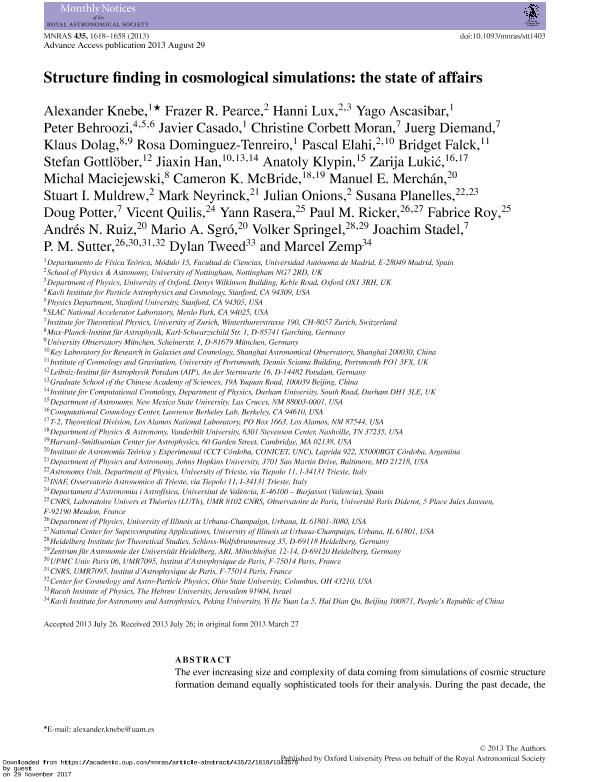Artículo
Structure finding in cosmological simulations: the state of affairs
Knebe, Alexander; Pearce, Frazer R.; Lux, Hanni; Ascasibar, Yago; Behroozi, Peter; Casado, Javier; Corbett Moran, Christine; Diemand, Juerg; Dolag, Klaus; Dominguez Tenreiro, Rosa; Elahi, Pascal; Falck, Bridget; Gottlober, Stefan; Han, Jiaxin; Klypin, Anatoly; Lukic, Zarija; Maciejewski, Michal; McBride, Cameron K.; Merchan, Manuel Enrique ; Muldrew, Stuart I.; Neyrinck, Mark; Onions, Julian; Planelles, Susana; Potter, Doug; Quilis, Vicent; Rasera, Yann; Ricker, Paul M.; Roy, Fabrice; Ruiz, Andrés Nicolás
; Muldrew, Stuart I.; Neyrinck, Mark; Onions, Julian; Planelles, Susana; Potter, Doug; Quilis, Vicent; Rasera, Yann; Ricker, Paul M.; Roy, Fabrice; Ruiz, Andrés Nicolás ; Sgró, Mario Agustín
; Sgró, Mario Agustín ; Springel, Volker; Stadel, Joachim; Sutter, P. M.; Tweed, Dylan; Zemp, Marcel
; Springel, Volker; Stadel, Joachim; Sutter, P. M.; Tweed, Dylan; Zemp, Marcel
 ; Muldrew, Stuart I.; Neyrinck, Mark; Onions, Julian; Planelles, Susana; Potter, Doug; Quilis, Vicent; Rasera, Yann; Ricker, Paul M.; Roy, Fabrice; Ruiz, Andrés Nicolás
; Muldrew, Stuart I.; Neyrinck, Mark; Onions, Julian; Planelles, Susana; Potter, Doug; Quilis, Vicent; Rasera, Yann; Ricker, Paul M.; Roy, Fabrice; Ruiz, Andrés Nicolás ; Sgró, Mario Agustín
; Sgró, Mario Agustín ; Springel, Volker; Stadel, Joachim; Sutter, P. M.; Tweed, Dylan; Zemp, Marcel
; Springel, Volker; Stadel, Joachim; Sutter, P. M.; Tweed, Dylan; Zemp, Marcel
Fecha de publicación:
10/2013
Editorial:
Oxford University Press
Revista:
Monthly Notices of the Royal Astronomical Society
ISSN:
0035-8711
Idioma:
Inglés
Tipo de recurso:
Artículo publicado
Clasificación temática:
Resumen
The ever increasing size and complexity of data coming from simulations of cosmic structure formation demand equally sophisticated tools for their analysis. During the past decade, the art of object finding in these simulations has hence developed into an important discipline itself. A multitude of codes based upon a huge variety of methods and techniques have been spawned yet the question remained as to whether or not they will provide the same (physical) information about the structures of interest. Here we summarize and extent previous work of the ‘halo finder comparison project’: we investigate in detail the (possible) origin of any deviations across finders. To this extent, we decipher and discuss differences in halo-finding methods, clearly separating them from the disparity in definitions of halo properties. We observe that different codes not only find different numbers of objects leading to a scatter of up to 20 per cent in the halo mass and Vmax function, but also that the particulars of those objects that are identified by all finders differ. The strength of the variation, however, depends on the property studied, e.g. the scatter in position, bulk velocity, mass and the peak value of the rotation curve is practically below a few per cent, whereas derived quantities such as spin and shape show larger deviations. Our study indicates that the prime contribution to differences in halo properties across codes stems from the distinct particle collection methods and – to a minor extent – the particular aspects of how the procedure for removing unbound particles is implemented. We close with a discussion of the relevance and implications of the scatter across different codes for other fields such as semi-analytical galaxy formation models, gravitational lensing and observables in general.
Archivos asociados
Licencia
Identificadores
Colecciones
Articulos(IATE)
Articulos de INST.DE ASTRONOMIA TEORICA Y EXPERIMENTAL
Articulos de INST.DE ASTRONOMIA TEORICA Y EXPERIMENTAL
Citación
Knebe, Alexander; Pearce, Frazer R.; Lux, Hanni; Ascasibar, Yago; Behroozi, Peter; et al.; Structure finding in cosmological simulations: the state of affairs; Oxford University Press; Monthly Notices of the Royal Astronomical Society; 435; 2; 10-2013; 1618-1658
Compartir
Altmétricas



